Get to know the place associated with the most famous myths of ancient Athens, the greatest religious festivals, the earliest cults, and several decisive events in the history of one of the most renowned ancient civilizations.
The Athenian Acropolis is one of the most important cultural monuments of the ancient world. Rising 157 meters above the Greek capital, the Acropolis has long symbolized the power of ancient Greece. The Acropolis consists of many structures, better or worse preserved, representing various orders and styles of classical art. Each of these structures stands in harmony with its natural surroundings, and together they form a mirror reflecting the life that thrived there thousands of years ago.
What is the Acropolis?
The name “acropolis” is a combination of the Greek words akros, meaning “highest,” and polis, meaning “city.” It’s easy to deduce that in ancient Greece, this term referred to the highest part of a city. However, it wasn’t just any district – it was the area where temples and palaces were typically gathered.
Instead of serving a residential function, the acropolis was primarily used for public and ceremonial purposes, addressing the needs of religious worship. The first acropoleis appeared on the map of Greece in the second half of the 2nd millennium BCE. While the most famous is undoubtedly the Athenian Acropolis, it is not the only one Greece can boast of. Other well-known acropoleis can be found in Mycenae, Thebes, and Corinth, among others.
The History of Athens’ Sacred Hill
The life on the most famous Athenian hill didn’t begin with temples. The earliest evidence of habitation in the area dates back to the Middle Neolithic period. In the 13th century BCE, a defensive wall was built around the settlement, primarily because it served as the residence of the local ruler.
However, it wasn’t until the 8th century BCE that the hill became filled with temples and gained prominence as a site for the worship of the goddess Athena. The sanctuary flourished, but the most significant period of its development is considered to be during the reign of Pericles, who initiated an ambitious construction project lasting throughout the second half of the 5th century BCE. It was during this time that the most important buildings on the Acropolis were constructed, including the Parthenon, the Erechtheion, and the Temple of Athena Nike.
In Roman times, the prestige of the upper city was maintained, but its glory eventually faded. After the establishment of Christianity in the 6th century, the temples were converted into Christian churches. For example, the Erechtheion became the Church of the Savior, and the Temple of Athena Nike became a chapel. Under Frankish occupation (12th-15th centuries), the Acropolis was transformed into the residence of their ruler, and during the Ottoman period (15th-19th centuries), it housed a Turkish army garrison. Since 1822, the Acropolis has been back in Greek hands, and in 1987, it was added to the UNESCO World Heritage Site list.
Touring the Acropolis
You can only access the Acropolis hill from its western side, either through the Beule Gate or the smaller entrance beneath the Temple of Athena Nike. Upon reaching the top, the upper city will leave you in awe. Surrounded by monumental structures and the remnants of ancient life, you’ll undoubtedly feel like you’ve traveled back in time. Towering over the entire Greek capital is the Parthenon, the largest and most important building on the Acropolis, though not the only one you’ll want to capture with your camera. So, what else can you expect to see?
GOOD TO KNOW: The Parthenon, overlooking Athens, is often confused with the Pantheon. While their names share a similarity, they are entirely different buildings. The Parthenon is a temple dedicated to Athena the Virgin, also known as Athena Parthenos, while the Pantheon refers to a temple dedicated to all gods (the most famous Pantheon is in Rome).
Propylaea – The Gateway to the Upper City
Such an extraordinary place as the Athenian Acropolis certainly deserved an extraordinary, fitting entrance. On the western side of the hill, precisely where the Mycenaean fortification’s gate once stood, the Propylaea was constructed. This marble structure is more than just a gateway; it serves as an exceptional frame for the sacred zone of Athens.
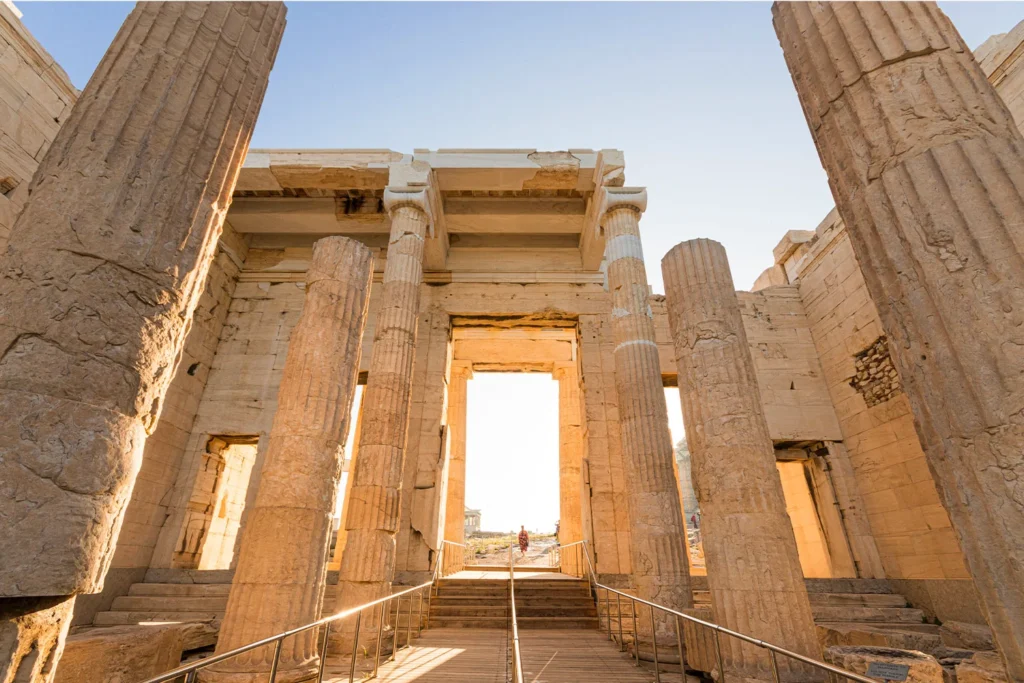
Its central section was supported by six Doric columns, between which stood a monumental wall with five doors. Two side wings flanked the central part, built lower due to the uneven terrain. The most famous part of these side chambers is the northern Pinakotheke, which, according to the traveler Pausanias, who wrote about this place in the 2nd century, was adorned with numerous, highly detailed paintings.
Temple of Athena Nike
The Temple of Athena Nike, also known as Athena the Victorious, stands on the southern edge of the Acropolis hill. Despite being dedicated to the most important goddess of the Acropolis, the temple is relatively small. The present classical sanctuary, designed in the Ionic style by architect Kallikrates, replaced an earlier temple dedicated to the same goddess. Despite its modest size, it attracts considerable attention, particularly due to the four monolithic columns found on both shorter sides of the building.
Originally, the central chamber of the temple housed a unique statue of Athena Nike. The goddess of victory held a pomegranate in her right hand and a helmet in her left. The original statue, dating from the Archaic period, was destroyed by fire in 480 BCE, but after the temple was rebuilt, the statue was recreated. Be sure to take a moment to admire the frieze depicting an assembly of Olympian gods and the temple’s remarkable balustrade adorned with relief sculptures. The most famous decoration on the balustrade was the depiction of Nike adjusting her sandal, which is now housed in the Acropolis Museum.
Parthenon – In Honor of Athena the Virgin
At the very top of the Acropolis hill reigns the Parthenon, a name familiar to most. Dedicated to Athena Parthenos, the temple is considered not only the most magnificent structure on the Acropolis in terms of design and execution but also the most perfect Doric temple of classical antiquity. The temple is surrounded by eight columns on each of the shorter sides and seventeen columns along the longer sides.
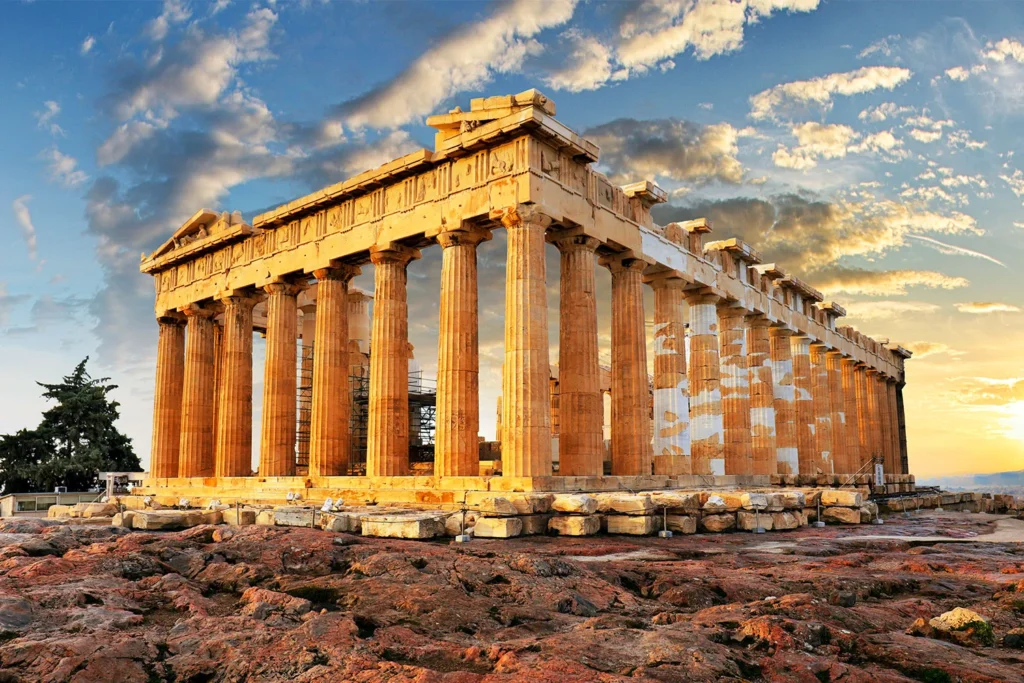
The interior of this architectural marvel was quite innovative for its time. A double colonnade served as a backdrop for the golden statue of Athena Parthenos, made of ivory and gold. The statue depicted the goddess fully armored, holding Nike (the personification of victory). Of particular note was the west chamber, adorned with four Ionic columns, where most of the city’s treasures were stored. The temple was further adorned with marble statues in its pediments, reliefs, and a remarkable frieze occupying the upper section of its walls.
The Parthenon retained its form and function until the 5th century, when it was converted into a Christian church dedicated to the Virgin Mary. Under Turkish rule, it became a mosque, and in 1687 it suffered severe damage during a bombing campaign, leading to significant destruction. Sadly, in the early 19th century, the temple was further devastated. Lord Elgin looted much of the temple’s sculptural decorations and sold them to the British Museum, where some of them remain to this day.
FUN FACT: Imagine seeing the Parthenon in its original, pristine condition! Surprisingly, this is possible—a full-scale replica of the original Parthenon in Athens stands in Nashville, Tennessee, USA. It was built in 1897 for the Tennessee Centennial and International Exposition and now functions as an art museum.
Erechtheion
Built in 406 BCE, the Erechtheion is an Ionic temple located on the northern side of the Acropolis plateau. Its name honors Erechtheus, the mythical king of Athens, though the temple was actually dedicated to both Athena and Poseidon. The temple’s unique shape results from the uneven terrain on which it stands—there’s a difference of three meters between its east and west sections.
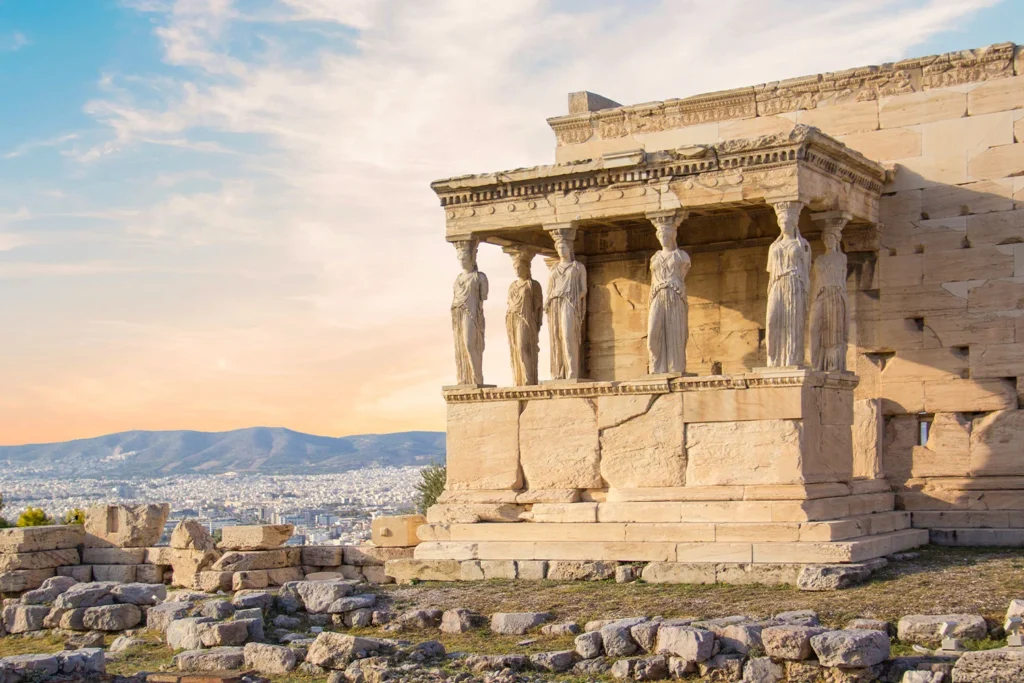
In ancient times, the temple housed a cult statue of Athena made of olive wood, though today it can only be imagined. Inside, you’ll want to note the magnificent portico on the northern wing, while on the southern side is the famous Porch of the Caryatids, the above-ground tomb of the mythical king of Athens, Cecrops. Instead of columns, six female statues (Caryatids) support the roof. The figures you’ll see are replicas, but five of the original statues are housed in the Acropolis Museum, and one resides in the British Museum.
Other Buildings of the Acropolis
The rich history and complex architecture of all the structures on the Acropolis cannot be fully described in just one article. However, it’s important to remember that the previously mentioned buildings are only part of the treasures found on this historic hill. For instance, near the Temple of Athena Nike, you can still spot remnants of columns that were once part of the Sanctuary of Aphrodite Pandemos, and opposite the northern wing of the Propylaea, you’ll find the Agrippa Monument, which once supported a structure offered to the city of Athens by Marcus Agrippa.
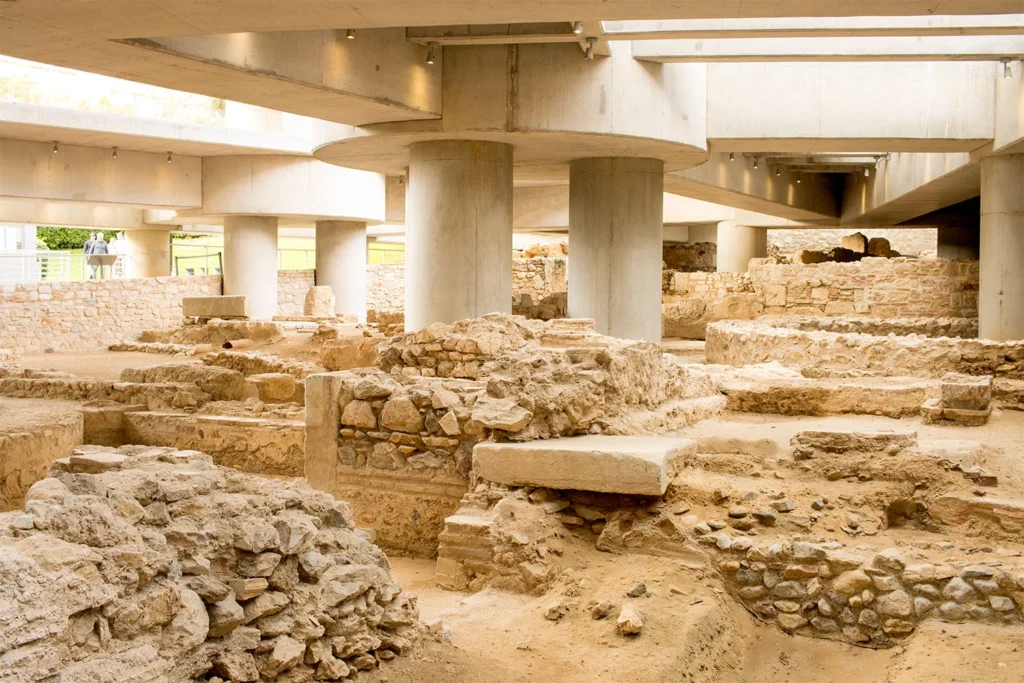
Walking along the southern wall, you can also find traces of the Brauroneion, a temple dedicated to Artemis Brauronia, and the Chalkotheke, a building where votive bronze offerings were stored. On the northern side of the hill stands the Erechtheion, the Ionic temple dedicated to Athena and Poseidon, as well as the Arrhephorion, a small square building where the Arrhephoroi (women tasked with weaving sacred garments for the festival commemorating Athena’s birth) once lived.
At the Foot of the Acropolis
If your goal is to explore every corner of this exceptional archaeological site, make sure to also visit the structures located at the foot of the Acropolis. One of the most impressive is the Odeon of Herodes Atticus, a remarkably well-preserved theater. This once-roofed venue was built by the ancient philosopher Herodes Atticus in memory of his beloved wife. The structure could accommodate up to 6,000 spectators, who gathered to watch performances and musical competitions.
You also won’t want to miss the other nearby remnants of Greece’s love for theatrical art. Though not as well-preserved as the Odeon of Herodes Atticus, the Theatre of Dionysus was once just as frequently used. In fact, it was one of the most important theatres of its time and served as the model for all later Greek theatres. Located right next to the Theatre of Dionysus was the Odeon of Pericles—likely the first covered theatre in antiquity.
The Acropolis Museum
If you enjoyed your walk around the Athenian Acropolis, it’s worth considering a visit to the nearby Acropolis Museum. This museum was created to display a vast array of artifacts discovered on and around the limestone hill, offering insight into the lives of ancient Greeks. You’ll explore five floors, with three levels dedicated to exhibits showcasing incredible pieces that will surprise you with even more fascinating aspects of the ancient world. Many believe that the artworks housed here are just as, if not more, impressive than the structures on the Acropolis itself.
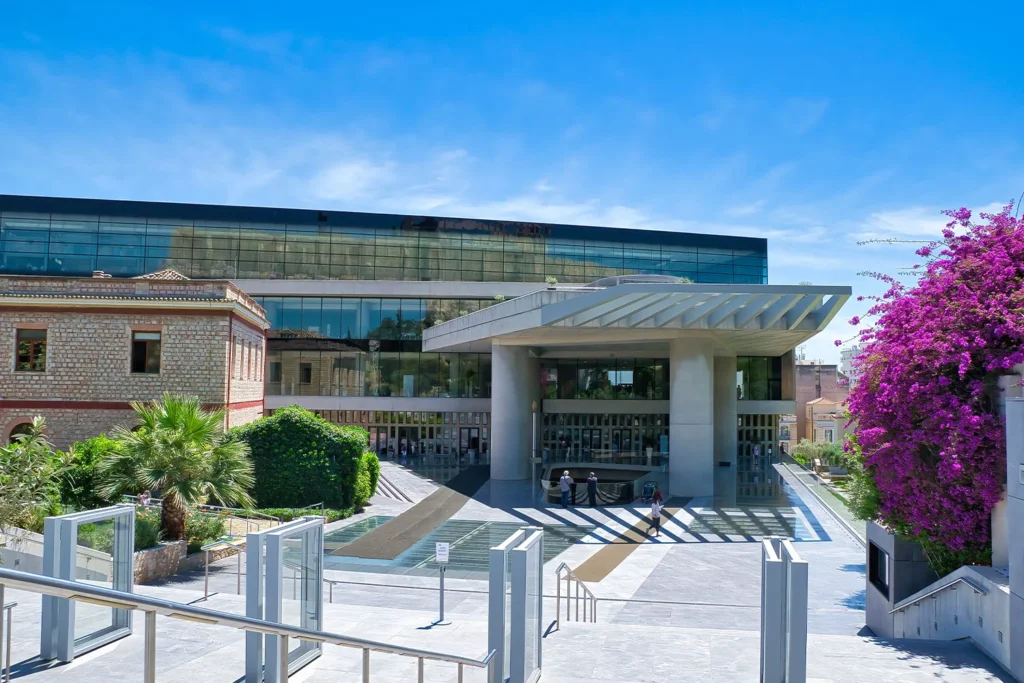
One of the most remarkable features of the museum is its underground level, which contains archaeological excavation sites. You don’t even need to descend below ground to view them; the excavations can be admired from the upper floors through a series of well-placed glass floors. It’s an exciting way to enhance your visit, especially on the second floor, where you’ll find a reading area, multimedia center, bookstore, and a charming terrace.
When visiting the museum, be sure not to miss the Gallery of the Slopes of the Acropolis, located on the ground floor. This section showcases finds from the sanctuaries established on the slopes of the hill, as well as everyday items used by ancient Athenians. The tour will then lead you to the Archaic Gallery, where you’ll encounter sculptures that adorned the first temples, along with votive offerings made by worshippers and pilgrims. These include statues of the goddess Athena, marble reliefs, and smaller offerings made of bronze and clay. The tour culminates on the third floor in the Parthenon Gallery, a glass-walled space where you’ll be able to admire the sculptures of the Parthenon frieze and reliefs depicting scenes from Greek mythology.
What to Know When Planning a Trip to the Acropolis
Regardless of whether you opt for standard tickets, guided tours, audio tours, or skip-the-line options, it’s best to book your tickets online (you can find them here). This will save you considerable time spent waiting in line. If you’re looking for a more budget-friendly option, consider purchasing a combined ticket. This special pass will be useful if you plan to visit not only the Acropolis but also the Roman and Greek Agoras, Hadrian’s Library, the Temple of Zeus, and Aristotle’s Lyceum within a five-day period.
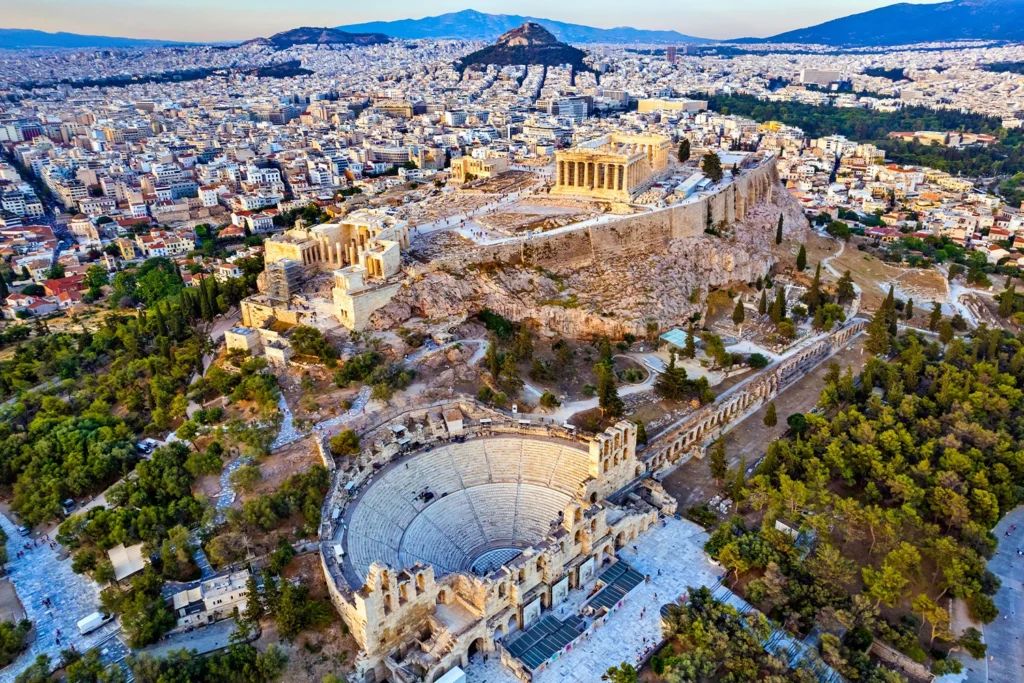
Keep in mind that during the summer months, the Acropolis is particularly crowded with tourists, and the heat can be intense. To avoid both the crowds and the midday sun, aim to visit in the early morning hours—this way, you can explore with much more comfort. To enjoy the Parthenon and the panoramic views of Athens from the top of the hill, you’ll need to make a short climb. The good news is that the path is relatively easy and pleasant, but it’s advisable to wear comfortable and stable shoes, as the rocks can be quite slippery. For visitors with mobility issues, special elevators are available to take guests directly to the top of the hill.
Practical information
- It is best to purchase tickets for the Acropolis in advance. This way, you can avoid standing in long lines and reduce the risk of tickets being sold out.
- Address: Athens 105 58, Greece
- Buy tickets on GetYourGuide